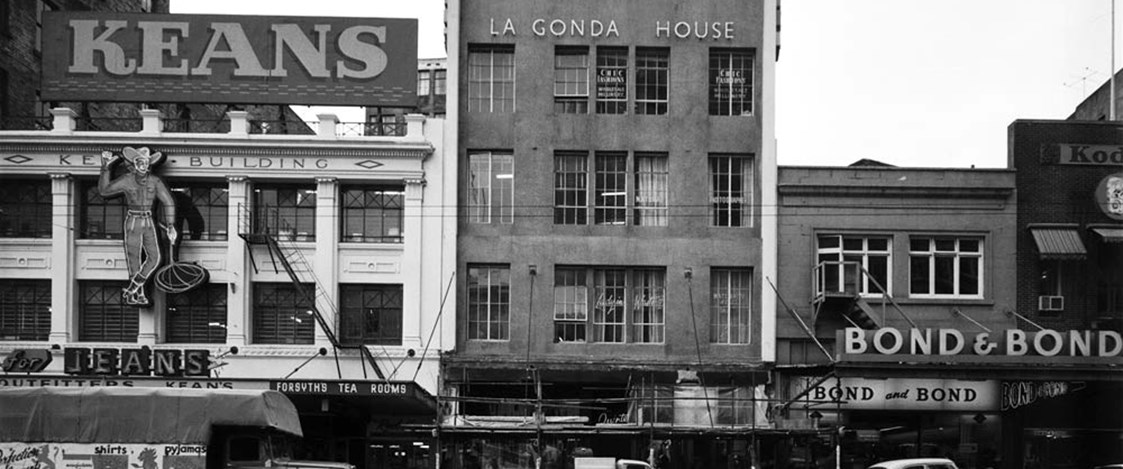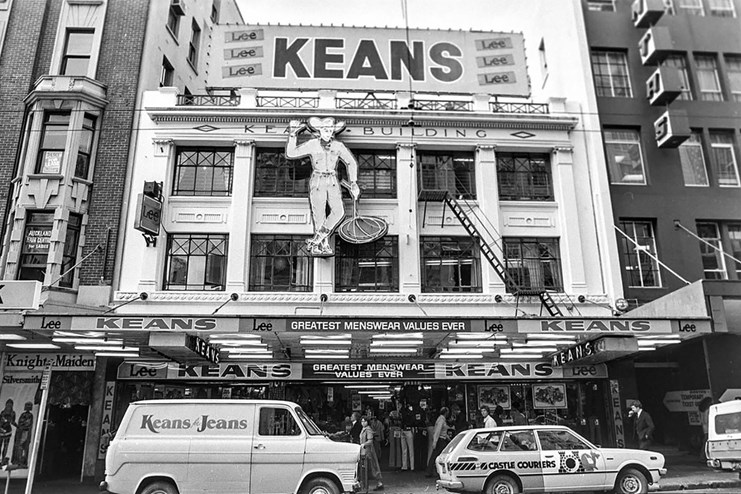Stories
Keans Jeans
1912-1993

For over half a century Kean’s Ltd was New Zealand’s largest supplier of what would become the world’s dominant fashion garment - jeans. The company had its origins in 1909 in Wellington, when P F (Frank) Kean and C O (Joe) Josephson, with 22 years of collective experience in the local clothing industry, went out on their own and opened a store on Willis Street. When it came to a name for the new business they decided on Kean’s, it being easier to say than Josephson’s.
Styling themselves 'Seamen’s Outfitters', they were the New Zealand agents for the Liverpool company of J J Rayner and Sons, suppliers of uniforms to the Royal Navy, steamship companies and for other occupations.
Kean and Josephson’s arrangement was formalised in 1912 when, with two other partners, they established Kean’s Ltd, to operate as general mercers and clothiers at Wellington, and now also in premises in Quay Street, Auckland.
Among the lines stocked by Kean’s at this time were boiler suits, available in a range of materials including twill, drill and denim (brown and blue). Hard-wearing denim clothing had been available in New Zealand since the 1860s, when there were auctions in Auckland of imported 'blue mottled denims' and 'blue jeans'. Curiously, the blue jean as we know it is said to date from 1873 when Levi Strauss and Jacob Davis of San Francisco obtained a U.S. patent on the process of putting rivets in men’s work trousers.
Levi Strauss’s revolutionary jeans – which had the additional benefit of double-stitching - were available in New Zealand by the 1890s, as was the Boss of the Road range made by another San Francisco manufacturer, Neustadter Bros.
The jeans stocked by Kean’s proved popular. In September 1921 a seaman in Auckland was sentenced to two months’ imprisonment after being convicted of stealing 11 pairs of denim trousers from the Quay Street store.
In the beginning jeans were designed for miners, mechanics and other labouring types. The trouser’s social migration began in the early 1950s, a result of the increasing influence of Hollywood and American popular culture. Young New Zealanders could now be outfitted in blue denim, just like cowboys from the Wild West. However, the idea of the workingman’s pants being acceptable streetwear was unpalatable to many. But when worn by movie stars Marlon Brando and James Dean, jeans became a potent symbol of youthful rebellion. Taken up by an emerging generation of teenagers, they began their spectacular transformation, to become a ubiquitous and universal fashion item.
Kean’s only ever had one store in Wellington, but over time expanded to eight outlets in the Auckland region, the main one being at 146-152 Queen Street. In November 1927 it was announced that construction was about to begin on this building, designed by Australian-born architect Arthur Sinclair O’Connor. It would be in the 'Neo-Greek style' and an eight-storey 'sky-scraper' rising to 102 ft. (31 m). But within a couple of months it seems Kean’s new flagship premises would be a much more modest three storeys high. The building was completed by January 1929 at a cost of £40,000.

Keans Jeans store on Queen Street in Auckland, circa 1979. All Rights Reserved, Image © Chris Traill.
Kean’s had its own factories in Matamata and Rotorua, making jeans from imported denim and supplying various other stores - including the Hallensteins chain - around the country. For a period in the mid-20th century, Kean’s could claim to have the New Zealand jeans market sewn up.
In the pre-television age Kean’s profile was maintained by a radio jingle, rich in cowboy references and sung to a jaunty arrangement by Auckland musician Crombie Murdoch. The first of the five verses went:
Got me the latest jeans in town,
Yippee-o, yippee-o-i!
Got me a gal with eyes of brown,
Lucky guy, lucky guy,
The guy with the jeans from Kean’s!
The country and western connection was further celebrated by a five-metre neon sign outside Kean’s Queen Street store, a cowboy resplendent in blue jeans and red bandana and twirling a lasso.
Kean’s may have catered for cowboys, but women customers at first had no option but to make do with men’s jeans. In 1955, perhaps honouring the earlier Boss of the Road brand, Kean’s trademarked their own Boss brand, and later became the sole importers of Lee jeans from America.
Ian Watkins directing a television commercial for Kean's Jeans in the NZBS AKTV-2 studios in Shortland Street, Auckland (later the NZBC studios), 1961. Photo by Alton Francis, courtesy of Manukau Research Library.
But while the company once had the market mostly to itself, there were now significant changes afoot. In response to the rapidly growing popularity of denim overseas, specialised jean shops were now springing up around New Zealand, providing stiff competition for the older and family-owned menswear stores. In 1972 this competition included the relaunching in this country of the pioneering Levi’s brand, the new market leader and about to celebrate its centenary.
By the mid-1970s, the three directors of the now Auckland-based Kean’s were all members of the Josephson family. The following decade was the age of deregulation and corporate raiding, and Kean’s main asset now was its prime Queen Street building. Property developers swooped, and the Kean’s name and business was sold to another long-serving company in the clothing trade, Warnocks.
Warnocks began in 1910, only shortly after Kean’s, when Thomas Warnock opened a drapery in Whanganui. His business flourished, and was bought out by Hallensteins in the 1950s. Meanwhile, Thomas’s son Owen had taken over the mens and boyswear side of the business, trading under the Warnocks name. In 1982 it went into partnership with footwear specialist R. Hannah and Co. Ltd, and later bought the Kean’s business. But in 1993 Warnocks would also become another casualty of the rapidly changing retail sector, going into voluntary receivership with the closure of 36 menswear stores around the country.
With the demise of Kean’s, the landmark 'Kean’s Cowboy' neon was removed from Queen Street and served for a period outside Armadillo Restaurant in Symonds Street. Meanwhile, the old Kean’s building in Queen Street would later be bought by the Guardian Trust.
Manufacturers and retailers such as Kean’s and Warnocks have come and gone, but jeans have proved remarkably resilient. In order to survive they have moved with the times. Wearers once allowed their denims to fade naturally, and gracefully, but they are now subjected to more drastic measures. But stonewashing, bleaching, ripping and other forms of premature ageing are not such a new idea; in March 1862 'mottled blue jeans' were already available in New Zealand.
Text by Richard Wolfe. Banner image by Clifton Firth, courtesy of Auckland Libraries Heritage Collections, 34-R493B.
Published April 2017.